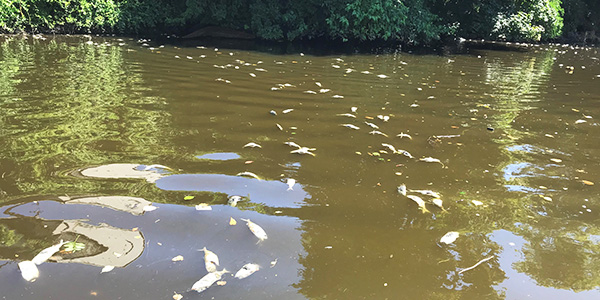From a distance, they could easily be mistaken for discarded trash bobbing on the surface of the water. When you get closer, though, and get a better look, you realize what you’re looking at: dead fish, often Atlantic menhaden (aka bunker).
It can be a troubling sight, for sure, especially when it’s more than a single dead bunker. And it can be worrisome when you don’t know what caused the death of these fish.
What you’re seeing during the summer on and around Long Island Sound is not always abnormal, nor is it cause for immediate alarm in some instances. Rather, it’s important to understand the forces that are likely to have contributed to the loss of the fish you happened across and to be ready to report your observations to groups that are able to further assess the situation.
The cause of the many of these fish die offs is hypoxia, which is when levels of dissolved oxygen (DO) in the water drop too low to support fish such as bunker. When DO levels are low, fish can literally suffocate in the water.
Chronic and acute hypoxic conditions can result from the input of excess nitrogen into the water. For example: the prevalence of excess nitrogen, to the point of it being a pollutant, in areas where large volumes of stormwater carry water contaminated by lawn fertilizer, which is rich in nitrogen; old and outdated septic systems; wastewater treatment plants not meeting permits for their discharges; and locations receiving combined sewer overflows during rainstorms.

There are other reasons DO levels can plummet. Fish can draw down oxygen levels in the water when they swim through it, and schools of bunker can be massive. Sometimes, a large number of bunker can be chased by predators into shallow waters where they become trapped and use up available oxygen in the water. There may have been some available oxygen when they arrived, but the increased activity and presence of so many fish can deplete the oxygen to a point where it becomes deadly for them. This can also happen in inlets and harbors where the flow of the water is naturally constricted, as one of our teams recently witnessed in a section of the Hutchinson River. These scenarios are often exacerbated by excessive nitrogen in addition to naturally occurring conditions.
Climate change is another contributing factor. Warm water doesn’t hold as much oxygen as cooler water does, and these fish kills could become more prevalent as Long Island Sound waters continue to warm up, making further nitrogen reduction actions even more important. Warm waters also tend to harbor more bacteria in the Vibrio genus that are naturally occurring but can lead to fish and other animal mortality. We saw this happen in 2020-2021 with bunker die offs through the fall and into winter when DO levels aren’t typically low.
All of these factors are concerning, which is why monitoring and measuring ecological health is such a vital part of the work of our water quality team. Through the Unified Water Study, for example, Save the Sound and 25 partner groups monitor DO and other water quality parameters related to this issue in a combined 44 bays and harbors around the Sound, in part to identify areas where the health of a water body is compromised and needs restorative actions.
And it certainly helps to have an aware and informed community. We hear all the time from residents alarmed by the sight of dead bunker, and we encourage you to alert local authorities when you spot a significant fish die off. To report a concern, please contact fishkillmarine@dec.ny.gov in New York, deep.marine.fisheries@ct.gov or deep.inland.fisheries@ct.gov in Connecticut, and be sure to copy us (pollution@savethesound.org).
